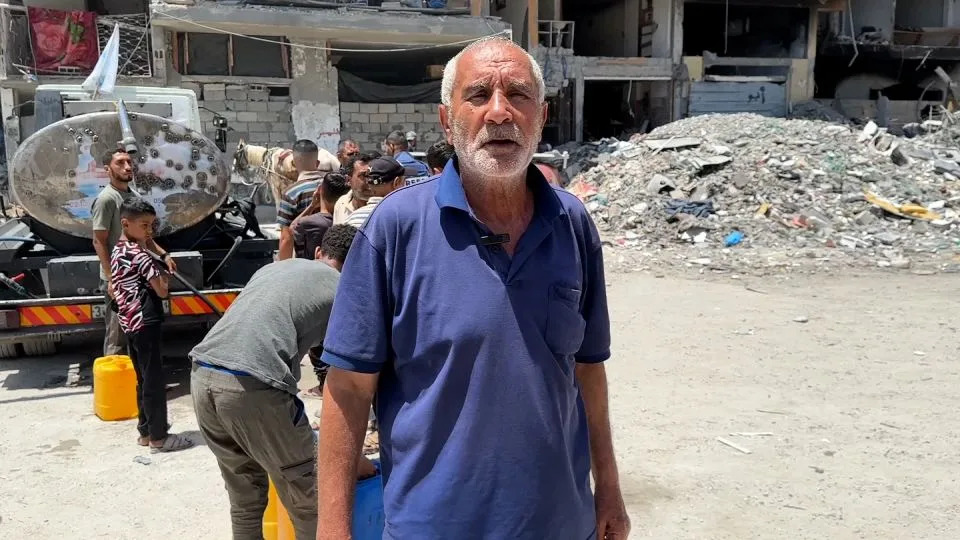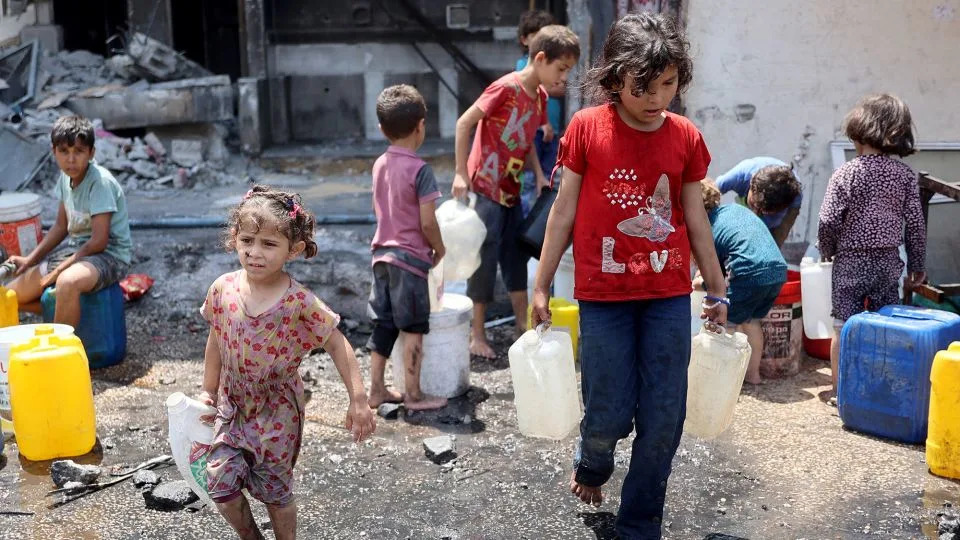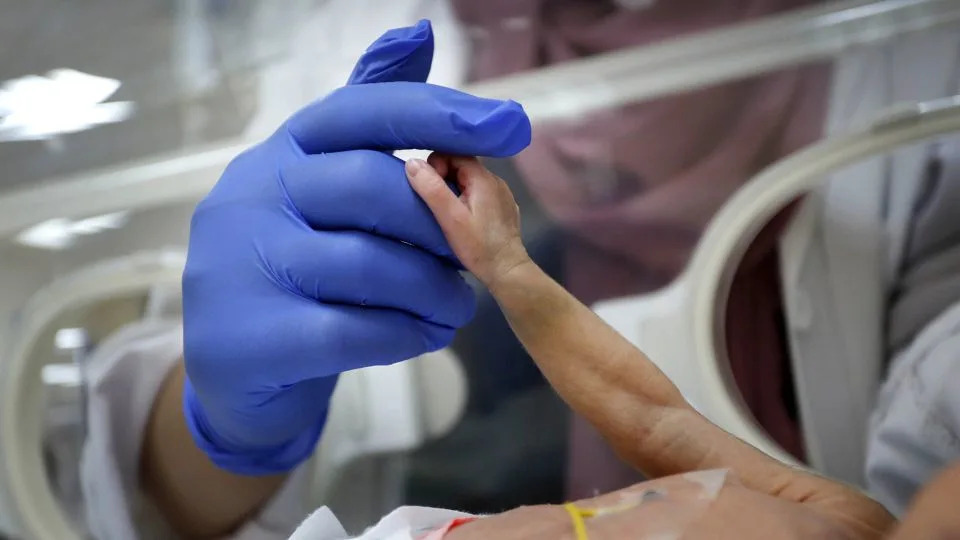Younis lays disorientated on a green mattress in Nasser Hospital, in southern Gaza. His long brown eyelashes rest delicately on his pale sunken face, as he drifts in and out of sleep.
The 9-year-old Palestinian boy lies in his mother’s arms, clearly wasted from severe malnutrition and suffering from dehydration. His blue jogging bottoms hang off his emaciated legs, as his tiny ribcage protrudes from his billowy orange T-shirt.
“I call on people with conscience to help me find health care for my son, so that he can go back to normal,” his mother, Ghanima Juma’a, told CNN last week at the hospital in Khan Younis. “I am losing my son in front of my eyes.”
Two months ago, the family was forced to flee the southern city of Rafah as Israel ramped up its attacks there. These days, they struggle to survive, living along the polluted coastline of Asda’a — near the Al-Mawasi tent camp — where they cannot find enough food, water, or even shade from the Gaza heat.
“We have to keep moving from one area to the other because of the war and the invasion… Life is difficult,” his mother said. “We don’t even have a tent over our heads.”
Israel’s war in Gaza has depleted the territory’s health system, leaving staff unable to treat malnourished children. Doctors told CNN they are being forced to turn away parents begging for baby milk, unable to even triage young patients with chronic illnesses compounded by severe hunger.
And as Israel continues its siege on Gaza, preventing aid groups getting enough food into the enclave, parents say they have no choice but to watch their children starve to death. More than eight months of bombardment has shredded infrastructure, wiped out communities and laid waste to entire neighborhoods. Sanitation systems — already stressed by water shortages from extreme heat — have been heavily destroyed, according to the UN, diminishing access to clean water.
A report published Tuesday by the Integrated Food Security Phase Classification (IPC), which assesses global food insecurity and malnutrition, warned that almost all of Gaza will face famine within the next three months.
The UN’s food agency earlier warned that southern Gaza could soon see the same “catastrophic levels of hunger” recorded previously in the north, where Israel concentrated its military offensive in the early days of the war.
At least 34 children have already died of malnutrition in Gaza, the government media office reported on June 22. The true number could be higher, as limited access to Gaza has impeded aid agencies’ efforts to fully assess the crisis there. More than 50,000 children require treatment for acute malnutrition, the UN’s agency for Palestine refugees (UNRWA) said earlier this month.
Israel launched its military offensive in Gaza after the Hamas-led October 7 attacks on southern Israel, in which at least 1,200 people were killed and more than 250 others were abducted.
Israeli attacks in Gaza have since killed 37,658 Palestinians and injured another 86,237 people, according to Gaza health officials.
Severe water shortages
As Younis suffers in his mother’s arms in Gaza’s south, children in the north have been dealing with food shortages even longer. In the Jabalya refugee camp, they queue at a water truck, beads of sweat rolling down their faces, as they weave through the rubble-filled streets.
Dozens of other Gazans crowd together to access water as aid workers nearby distribute thick, steaming red soup from large saucepans.
It’s rare access to food and clean water. Those in the north told CNN they have resorted lately to drinking polluted water, which does little to help dehydration and spreads infectious diseases.

Israel insists there is “no limit” on the amount of aid that can enter Gaza, but its inspection regime on trucks, restrictions on land routes and increased bombardment means relief is barely trickling in. Even when aid enters the besieged territory, the risk of hungry Palestinians scrambling over convoys hampers distribution efforts. UN Secretary General António Guterres recently warned the absence of police authorities in Gaza during the conflict had led to “total lawlessness.”
Earlier this year, the UN warned that Israel is creating an “entirely man-made disaster” in Gaza. Israeli Prime Minister Benjamin Netanyahu has denied allegations by the International Criminal Court’s chief prosecutor that he has used “starvation of civilians as a method of warfare.”
“The only water we have is what we get as aid. People are suffering as a result, it is indescribable,” said one civilian named Hassan Kalash. “We are ill and don’t have the strength to transport the water… The water pipe is broken. We do not have water infrastructure.”
Civilians there told CNN they have no access to running water, relying on scant aid entering the area. At least 67% of water and sanitation facilities in the Gaza Strip have been destroyed or damaged in the eight months of bombardment, UNRWA said last week. All of five wastewater treatment plants in Gaza have shut down, according to the UN Environment Programme.

The UN’s Office for the Coordination of Humanitarian Affairs (OCHA) has accused Israeli authorities of obstructing humanitarian access to northern Gaza. In the first three weeks of June, 36 trucks carrying aid — which were facilitated by Israel — were allowed to reach Gaza, while another 35 were either denied access, impeded or canceled due to logistical, operational or security reasons.
The impact on the ground is visceral. In Al-Aqsa Martyrs Hospital in central Gaza, 5-year-old Razan wears a gold ring on her finger, which is covered in red sores. The Palestinian girl is sprawled on a trolley in the central Gaza facility, her grey eyes weary with exhaustion.
“She changed after the war. She became weak,” her aunt, Um Razan Mheitem, told CNN, adding that her niece had developed skin inflammation due to malnutrition. “We cannot find anything for her. Everything in the market is expensive, or not available.”
‘Waiting for them to die, one by one’
Newborn babies and pregnant women are among the most at risk of malnutrition and dehydration in Gaza, according to aid agencies and health workers. Undernourished mothers are more likely to give birth prematurely, with newborns dying because they weigh too little.
At the Kamal Adwan Hospital in northern Gaza, doctors were unable to keep baby Amal alive just four days after her birth.
CNN filmed the moments before her death, showing Amal drawing heavy breaths in an incubator, after her mother, Samaher, gave birth two months prematurely. Her tiny pink toes are covered in plastic tubes.
“These babies are dying. It is God’s decision, but it is caused by people,” her father, Ahmed Maqat, told CNN, after she died on Saturday. Samaher had endured months of her pregnancy without sleeping, eating or drinking, Maqat said.
“Everyone in these beds today is at risk of dying. We are waiting for them to die one by one,” he added, his voice quivering with grief. “We have no life.”
AfriPrime App link: FREE to download...
https://www.amazon.com/Africircle-AfriPrime/dp/B0D2M3F2JT

Dr Ahmed Kahlot, head of the incubators department at Kamal Adwan, told CNN that Samaher’s poor health meant her daughter was just “waiting for death.”
Many of those who do survive are too dehydrated and malnourished to breastfeed their children. But health workers told CNN there are few alternatives, with shortages of lactose free or soya milk for infants.
Another Palestinian in Kamal Adwan Hospital told CNN that her son, who suffers from an inflamed esophagus, is unable to access soya milk, which he needs in his condition. “He hardly sits,” she said of her 2-year-old child. “He cannot even crawl, cannot walk.”
Around 250 patients are receiving treatment for malnutrition at the hospital, and there are only two functioning stabilization centers for severely malnourished children in Gaza, OCHA reported earlier this month, endangering almost 3,000 children, who were receiving treatment for acute malnutrition in the south prior to the military escalation in Rafah.
Doctors say they are often unable to treat babies who show symptoms of malnutrition, including breathing problems, chest infections, and severe dehydration, amid dwindling medical supplies. Malnourished patients with chronic or infectious illnesses are less likely to recover, a local pediatrician told CNN, as the spread of disease spikes in displacement shelters. Authorities in Gaza have recorded more than 1.4 million cases of infectious diseases since October 7, according to the Ministry of Health there.

As hunger worsens and parts of the enclave hurtle towards widespread famine, aid agencies have repeatedly called for the opening of land crossings into Gaza, which they say are the most effective way of getting relief into the strip. A US-built floating pier designed to bring in aid in by sea has been beset by problems — from unfavorable sea conditions to distribution issues once the aid ins transferred on land — failing to make a meaningful difference to the crisis.
Back in Khan Younis, Ismail Madi told CNN last week how worried he was for his 4-year-old son, Ahmad, who was suffering jaundice from malnutrition.
“My son will not be able to survive this,” he said. “I call on the American president Joe Biden… to intervene,” added Madi, “to save this child who has nothing at all to do with any political conflict.”
But just days later, the boy died. With other young children to provide for, Madi’s life as a parent is full of stress.
“It’s very hard to feed a family of 10 in these difficult times.”
AfriPrime App link: FREE to download...
https://www.amazon.com/Africircle-AfriPrime/dp/B0D2M3F2JT
Experts say Gaza is at 'high risk' of famine despite increased aid to the north
An influx of aid appears to have eased a hunger crisis in northern Gaza for now, but the entire territory remains at “high risk” of famine after Israel's offensive in Rafah caused displacement and the disruption of aid operations in the south, a draft report said Monday.
The report by the leading international authority on the severity of hunger crises said nearly everyone in Gaza is struggling to get enough food and that more than 495,000 people, or greater than a fifth of the population of 2.3 million, are expected to experience the highest level of starvation in the coming months.
That's despite months of U.S. pressure on Israel to do more to facilitate aid efforts, the installation of a $230 million U.S.-built pier that has been beset by problems and repeated airdrops by multiple countries that aid agencies say are insufficient to meet vital needs.
Israel invaded Gaza after Hamas' attack on Oct. 7, in which Palestinian militants killed around 1,200 people, mostly civilians, and abducted about 250. The war has killed more than 37,000 Palestinians, according to the Gaza Health Ministry, which doesn't say how many were civilians or fighters.
Israel imposed a complete siege on the territory at the start of the war and has only gradually eased it under pressure from Washington. The war has destroyed most of Gaza's capacity to produce its own food.
The latest findings come from the Integrated Food Security Phase Classification, or IPC, an initiative first set up in 2004 during the famine in Somalia that now includes more than a dozen U.N. agencies, aid groups, governments and other bodies. The Associated Press obtained a draft of its latest report, the final version of which is set to be released Tuesday.
In its last report, in March, the IPC said that famine was “imminent” in northern Gaza, which has suffered widespread destruction and which Israeli troops have surrounded and largely isolated since the earliest days of the ground invasion. That report said that around a third of Gaza's population was experiencing stage 5 hunger — the highest level of starvation.
In April, after Israeli strikes killed seven aid workers and sparked international outrage, Israel promised to ramp up aid, and it later opened additional land crossings in the north. The IPC said the amount of food deliveries to the north “sharply increased.”
But in early May, Israel launched ground operations in the southernmost city of Rafah, leading to the closure of the Rafah crossing with Egypt and repeated disruptions to the nearby Kerem Shalom crossing with Israel. The air and ground operations also displaced more than a million people, most of whom had already fled their homes earlier in the war. Many are now crammed into squalid tent camps where they are at heightened risk of disease outbreaks, which the IPC said could exacerbate the hunger crisis.
“The humanitarian space in the Gaza Strip continues to shrink and the ability to safely deliver assistance to populations is dwindling,” the draft report said. “The recent trajectory is negative and highly unstable. Should this continue, the improvements seen in April could be rapidly reversed.”
Children, especially those with underlying medical conditions, are particularly vulnerable.
Manal Nayef, from Rafah, has made multiple visits to the hospital since her son Karam was born underweight nearly three months ago. During a visit earlier this month, he lay with an IV drip in his hand, his lips seeking a breast but only sucking air.
“As a mother, I was not well-nourished,” his mother said. “And it is getting worse because he needs a special formula, and it is not available. He looks smaller than other children.”
A separate group of experts warned earlier this month that it's possible that famine is already underway in northern Gaza. The Famine Early Warning Systems Network, or FEWS NET, said the ongoing war and restrictions on humanitarian access impeded the data collection to prove it.
Stage 5 hunger is equivalent to famine, but the IPC only declares an entire area to be in famine when 20% of households have an extreme lack of food, 30% of children suffer from acute malnutrition and at least two adults or four children per 10,000 people die daily.
Israel says it allows hundreds of trucks to enter through multiple crossings on a near-daily basis and blames U.N. agencies for not distributing it, saying containers are stacking up at Kerem Shalom, Gaza's main cargo terminal.
U.N. agencies and aid groups say they often can't access Kerem Shalom because of fighting in the area and that Israeli restrictions, difficulties coordinating with the army and the collapse of law and order greatly hinder their work. They say it's impossible to address the crisis without a complete cease-fire.
The United States has rallied international support behind a proposal that would lead to the release of the remaining hostages and a permanent cease-fire, but neither Israel nor Hamas have fully embraced it.
Jeremy Konyndyk, president of Refugees International and a former official with the U.S. Agency for International Development, said the IPC report shows that even with massive U.S. and international pressure on Israel leading to larger volumes of aid, the situation remained dire.
“All that was achieved was ramping back an imminent famine to a high risk of famine,” he said. “And what that says is that there is still not unfettered aid access, unfettered aid delivery, as required by international law.”
He added that if aid flows are disrupted again, as they have been during the ongoing Rafah operation, “all that progress, modest and insufficient as it is, will be lost again.”
AfriPrime App link: FREE to download...


